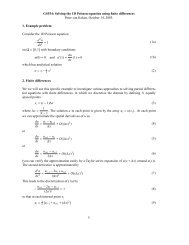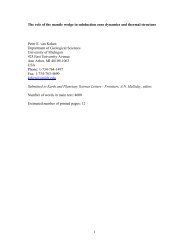Quantitative paleoenvironmental and paleoclimatic reconstruction ...
Quantitative paleoenvironmental and paleoclimatic reconstruction ...
Quantitative paleoenvironmental and paleoclimatic reconstruction ...
Create successful ePaper yourself
Turn your PDF publications into a flip-book with our unique Google optimized e-Paper software.
ARTICLE IN PRESS<br />
N.D. Sheldon, N.J. Tabor / Earth-Science Reviews xxx (2009) xxx–xxx<br />
35<br />
Fig. 20. δ 13 C vs. 1/X G of Fe(CO 3 )H component in solid solution in goethites from two different soils (Yapp <strong>and</strong> Poths, 1993; Yapp, 2004). The slope of the data array from the pedogenic<br />
goethites is related to atmospheric pCO 2 during the time of soil formation, <strong>and</strong> goethite crystallization. These data indicate atmospheric pCO 2 of 16×PAL during formation of a Late<br />
Ordovician paleosol from the Neda fm. in Wisconsin, U.S.A, <strong>and</strong> 9×PAL for a middle Eocene paleosol profile from the Ione fm. in California, U.S.A. See text for discussion.<br />
(CO 3 )OH in solid solution in goethite appear to be less abundant than<br />
paleosol profiles with calcite. In spite of these limitations, estimates of<br />
paleoatmospheric pCO 2 from Fe(CO 3 )OH in solid solution in paleosol<br />
goethites are tremendously important because they represent the<br />
only soil mineral that provides an internal proxy of soil pCO 2 , which<br />
greatly reduces the uncertainty of atmospheric pCO 2 estimates to<br />
about ±300 ppmV. It is likely significant, however, that paleoatmospheric<br />
pCO 2 estimates from paleosol goethites <strong>and</strong> calcites show the<br />
same general trends through time (Yapp <strong>and</strong> Poths, 1996; Tabor et al.,<br />
2004a,b).<br />
7.4.4. Soil carbonates formed by mixing of three-components of soil CO 2<br />
7.4.4.1. Calcite. As mentioned, 3-component CO 2 mixing includes<br />
CO 2 derived from (1) in situ oxidation of soil organic matter, (2)<br />
tropospheric CO 2 <strong>and</strong> (3) CO 2 derived from dissolution pre-existing<br />
carbonate. Soil calcite derived from 3-component soil CO 2 mixing is<br />
more likely to occur in soils <strong>and</strong> paleosols developed upon marine<br />
carbonate, because these environments have high concentrations of<br />
pre-existing carbonate. Furthermore, soil calcite formed upon marine<br />
carbonates is expected to have more positive δ 13 C values than coexisting<br />
soils characterized by 2-component <strong>and</strong> 1-component CO 2<br />
mixing, because marine carbonate is generally quite positive, usually<br />
greater than ~− 2‰. To date, the existence of soil calcite that records<br />
the effect of mixing of 3-components of soil CO 2 has not been<br />
demonstrated. Quade et al. (1989) isotope study of soil carbonate<br />
along an elevation <strong>and</strong> climate transect in the Great Basin, Nevada, U.S.<br />
A., included examples of pedogenic calcite from soils formed upon<br />
both siliciclastic <strong>and</strong> carbonate parent materials. That work observed<br />
a12‰ δ 13 C variation over a 2440 meter elevation change. Yet, the<br />
slope of calcite δ 13 C values versus elevation was similar for samples<br />
taken from soils on carbonate <strong>and</strong> siliciclastic parent materials. The<br />
similarity of calcite δ 13 C values among carbonate- <strong>and</strong> siliciclastichosted<br />
soils strongly suggests that there is complete exchange between<br />
HCO − 3 derived from dissolution of pre-existing marine calcite<br />
<strong>and</strong> CO 2 in the soil that is derived from oxidation of organic matter <strong>and</strong><br />
tropospheric CO 2 . The large variation in soil calcite δ 13 C values that<br />
was observed in Quade et al. (1989) is interpreted to reflect principally<br />
changes in the ratio of C 3 <strong>and</strong> C 4 photosynthesizers along the elevation<br />
transect. Nevertheless, we suspect that soil calcite that is formed by<br />
mixing of three-components of soil CO 2 exists, <strong>and</strong> will likely be found<br />
in soil profiles that are (1) developed upon marine carbonate, <strong>and</strong> (2)<br />
characterized by relatively low biological productivity. The former<br />
condition reflects that marine carbonate values have positive δ 13 C<br />
values, whereas the latter condition reflects that lower biological<br />
productivity will limit exchange with HCO 3 − derived from dissolution<br />
of pre-existing marine calcite <strong>and</strong> maintain a relatively positive δ 13 C<br />
value of micrite. In this regard, karst surfaces developed upon marine<br />
strata in times prior to evolution of vascular plants (pre-Silurian) may<br />
be a good c<strong>and</strong>idate for paleosol calcite that formed by mixing of 3<br />
components of soil CO 2 .<br />
7.4.4.2. Goethite. Hsieh <strong>and</strong> Yapp (1999) determined that Fe(CO 3 )OH<br />
in solid solution in goethite from a Rhodic Paleudult in east Texas,<br />
U.S.A., preserves δ 13 C values that range from −13‰ to −14‰ toward<br />
the surface of the soil (31–64 cm) to − 6‰ to − 4‰ at depths of<br />
122 cm beneath the surface. This depth-dependent trend of δ 13 C values<br />
is different from that expected in soils characterized by mixing of two<br />
components of soil CO 2 (Fig. 16), <strong>and</strong> was interpreted to be a result of<br />
incorporation of a fraction of dissolved carbonate that originated from<br />
dissolution of marine calcite fossils in the parent material (Eocene<br />
Weches Formation). More negative δ 13 C values of Fe(CO 3 )OH towards<br />
the surface of the soil were also interpreted to represent (1) more<br />
intense <strong>and</strong> longer-duration weathering toward the top of the profile,<br />
<strong>and</strong> (2) partial to nearly complete dissolution <strong>and</strong> re-precipitation of<br />
goethite after carbonate had been removed from that portion of the<br />
soil profile. Yapp (2001a, 2002) presented the following equation to<br />
explain the δ 13 C values of Fe(CO 3 )OH in solid solution in goethite from<br />
acidic soils characterized by three-component soil CO 2 mixtures:<br />
h <br />
<br />
δ 13 C G = X GA δ 13 C GA − δ 13 C GO<br />
<br />
+ X GS δ 13 C GO − δ 13 C GCC<br />
i<br />
<br />
1<br />
+ δ 13 C GCC<br />
X G<br />
ð56Þ<br />
With the exception of δ 13 C GCC <strong>and</strong> X GS , all variables <strong>and</strong> subscripts<br />
are defined in the manner for Eqs. (52) <strong>and</strong> (55). δ 13 C GCC is the δ 13 C<br />
value of Fe(CO 3 )OH in goethite if it were in equilibrium with aqueous<br />
CO 2 derived only from dissolution of pre-existing carbonate in the soil,<br />
whereas X GS is the mole fraction of Fe(CO 3 )OH in goethite if it formed<br />
only from CO 2 gas in a soil with mixing of two-components of CO 2 .<br />
Eq. (56) indicates that, in a plot of δ 13 C G vs. 1/X G , the Fe(CO 3 )OH<br />
component in goethite samples from the soil will yield a linear array<br />
with a negative slope (Yapp, 2001a,b; 2002; Tabor et al., 2004a,b;<br />
Tabor <strong>and</strong> Yapp, 2005b). Although it is not possible at this time to<br />
estimate paleoatmospheric pCO 2 concentrations from the δ 13 C<br />
<strong>and</strong> molar concentration of Fe(CO 3 )OH in goethites that formed in<br />
the presence three-component soil CO 2 mixtures, they do provide<br />
estimates of soil pCO 2 .<br />
Please cite this article as: Sheldon, N.D., Tabor, N.J., <strong>Quantitative</strong> <strong>paleoenvironmental</strong> <strong>and</strong> <strong>paleoclimatic</strong> <strong>reconstruction</strong> using paleosols, Earth-<br />
Science Reviews (2009), doi:10.1016/j.earscirev.2009.03.004















